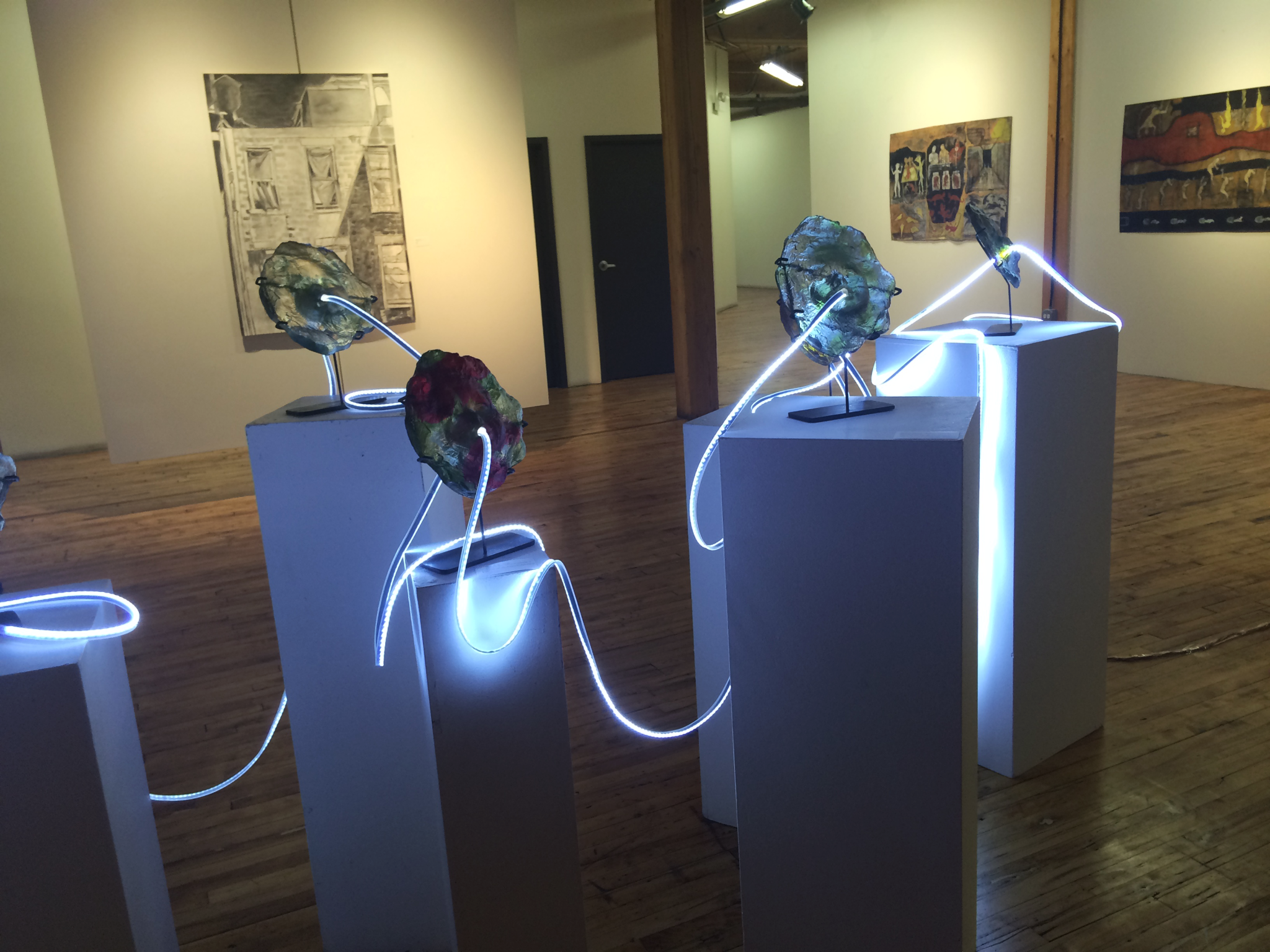Ten women, ten collections of individual life experiences, ten unique approaches to visual art––these all qualify as accurate descriptions of “Ten Chicago Women/Fifteen Years,” the current exhibition at the Bridgeport Art Center, which presents the fruits of fifteen years of work of ten female Chicago artists. And yet, despite their distinctions, words like unity, friendship, and collaboration are what most authentically represent these artists and their relationship to one another.
“We meet every six to eight weeks. We look at each other’s work, we critique it, we drink copious amounts of alcohol, and we eat dinner, and, you know, we talk about art,” said Suzanne Cohan-Lange, one of the artists. Another collaborator, Sharron Pierce, laughed and nodded in agreement, adding, “We go home and do our art, and when we’re stuck we’ll come back and bring a piece and say, ‘What do you think? I don’t know what to do, do you have any ideas?’”
These informal and lighthearted conversations have formed the structure of their collaborative artistic discourse for over fifteen years. The women initially came together as friends looking to support each other in a field they viewed as dominated by men.
“When Linda [Sorkin Eisenberg] and Elyn [Koentopp-Vanek] invited us, they invited women,” said Cohan-Lange. “We said we needed to support each other. That’s all. It was not an overtly political act.”
After Eisenberg and Koentopp-Vanek began collaborating, they each invited other independent artists, including many who had become friends while pursuing graduate art studies at Columbia College. Gradually the group blossomed to the ten women whose work can be viewed today at the Bridgeport exhibition.
In contrast with the collective nature of the group’s artistic discourse, each artist has remained highly specialized and idiosyncratic in her own craft. “I think that our work has remained true to who we are,” said Cohan-Lange. “What we do is we push each other to be better.”
Due to a variety of factors, each of the featured women’s art has evolved over the years. Lois Long, explaining the method behind her photography, said, “I continued with the mirrors and the glass because they became these things I could play with with the light because there’s still a reflective surface on it, so it creates a layering. As we get older, our lives become much more layered, and so I liked this idea that the layers were there. And it also reflects what it sees. And I think about the reflection not only in terms of physical reflection but also mental reflection.”
With this passage of time also came a necessary adaptation to new artistic methods. Though Long claimed she was “dragged kicking and screaming into digital,” she learned to effectively utilize the new medium. Her photographs reflect her evolving spirituality, introspection, and versatility; on display were strikingly vibrant shots that were both realistic and surreal, and which at times more closely resembled abstract painting than traditional photography.
Suzanne Cohan-Lange also attested to ability-related adaptations to her work she’s had to make over the years. “I always worked life-size,” she said. “I can’t do that anymore––it’s too hard. [Sharron Pierce] used to work on pieces that weighed 500-1000 pounds. You can’t do that once you get to be a certain age. And so you learn. I’m working in glass now, these head-sized pieces, since I can.” Cohan-Lange’s striking two-part display, “The Conversation: Talking to Ourselves,” incorporates cast glass, steel, and LED elements, with an array of subtle and detached faces interlinked through the mouth by a long illuminated ribbon.
“When I first started,” Cohan-Lange said, “I was welding life-sized figures. She [Pierce] was doing pieces of clay that weighed the same as a Buick. So you know, you adapt to what you can do.”
Despite these aforementioned changes, as well as the various life events, achievements, and challenges that each woman has experienced over the years, their friendship has only gotten stronger. They look forward to their meetings, itching for the critique to which they attribute their continued artistic growth. “Critique is not a bad word,” clarified Pierce. “It’s bad and scary for students usually, but it exists for positive reasons. It’s always positive. We ask for it. We wouldn’t bring our work if we didn’t want to be critiqued. And we grow from it.”
“Just little subtleties,” added Linda Sorkin Eisenberg, whose exhibited sculptures offer a complex and colorful rendition of the garments and personas behind select Greek goddesses and mythical figures. “It’s not like, ‘This is awful, you’ve got to change the color.’ It’s more suggestion.”
Since the group’s inception, the ten have had joint, cumulative shows of this nature almost every year. With such marked success, it’s no wonder that the women envision continuing on with the group as long as they can. As for diversifying the gender composition of the group, the women say they would be open to anyone who requested to join, though they cannot imagine a man electing to endure their chatter-filled, high energy meetings.
“When we have meetings in each other’s houses our husbands flee—they run upstairs,” Cohan-Lange explained.
“Or they leave the house,” said Pierce.
“We’re loud.” The two look at one another and laugh jovially.
“I mean this is serious work,” Cohan-Lange continued. “But that doesn’t mean that we don’t giggle and scream. And you can do that if you’re a room full of people that are supportive and not critical––there’s the difference. So it’s not about criticism, it’s really about construction, helping, collaboration.”
Bridgeport Art Center, 1200 W. 35th St., fourth floor. Open through December 31. Monday–Saturday, 8am–6pm; Sunday, 8am–noon. Free. (773) 247-3000. bridgeportart.com


Thank you for this